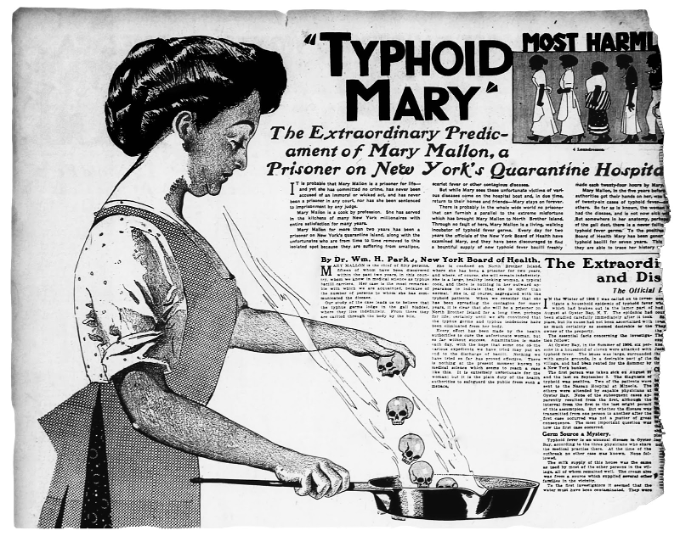By Nicole Gadda
Do you know the story of Typhoid Mary? Mary Mallon, otherwise known as Typhoid Mary, was born in Ireland in 1869 and immigrated to the United States in 1883. Mary worked as a cook and later became infamous for unknowingly spreading typhoid fever to the families she worked for. Typhoid fever is a bacterial infection caused by Salmonella typhi that causes fevers, headaches, and diarrhea.

It all started in the summer of 1906 when Mary began working as a cook for the Warren family on Long Island, NY and six people in the house suddenly fell ill with typhoid fever. The Warrens hired George Sober, a sanitary engineer, to investigate what caused the typhoid outbreaks at their residence. After exhausting every possibility, George looked into Mary’s employment history. What he found shocked him: 7 out of 8 of the families she previously cooked for also reported cases of typhoid fever!
How was Mary spreading the infection? Generally, typhoid fever is spread through drinking water contaminated by the excrement (yes, poop) of people with the illness. You guessed it – this means that Mary’s poor handwashing technique after using the restroom is likely to blame. Bacteria can be killed by the high heat of cooking – this is why raw meats like chicken must be cooked thoroughly before eating. However, Mary’s most popular dessert, homemade ice cream with raw, frozen peaches, was the perfect environment for Salmonella typhi to thrive and cause illness in those who ate it. How was Mary able to spread the disease but not become sick herself? She was an asymptomatic carrier of Salmonella typhi. In other words, Mary harbored the contagious bacteria and was capable of infecting others, but she never showed any symptoms.
When George Sober publicly released the news about Mary, the New York City Health Department took her into custody in 1907. The public opinion of her was negative, with cartoons printed in the newspapers labeling her as “Typhoid Mary.” Public health officials forced Mary into solitary confinement in order to keep anyone else from catching the infection. Mary was uncooperative and didn’t understand why she was being held against her will. She wrote, “I never had typhoid in my life and have always been healthy. Why should I be banished like a leper?” Mary was confined for 2 years, during which 120/163 of her stool samples tested positive for Salmonella typhi. In 1910, she was released back into the public, but on one condition: She was forced to promise she would never work as a cook again. Mary agreed.

However, Mary didn’t keep her promise. In 1915, Manhattan’s Sloane Maternity Hospital reported an outbreak consisting of 25 typhoid fever infections among doctors, nurses, and hospital staff. The source? A cook by the name of “Mary Brown” in the hospital cafeteria. Mary had given a fake name in order to find employment as a cook, which was her only source of income. Mary was a single, middle-aged Irish immigrant with no other options for employment that paid nearly as well as cooking did. Despite this, Mary was arrested by the New York City Health Department and placed in confinement, where she remained until her death 23 years later. By the time Mary had died, over 400 other asymptomatic carriers of Salmonella typhi were identified. However, no one else was forcibly confined to isolation like Mary. Do you think it was morally right for Mary to be forced into quarantine for the sake of public health? Could this have been prevented if the health department trained her in a different field of work, or educated her on how she was unknowingly spreading typhoid fever?
The story of Typhoid Mary happened over 100 years ago, but there are similarities to the pandemic happening in the world today. Mary was able to spread typhoid fever to the families she cooked for, but to the outside world, she looked like she was in picture-perfect health. Similarly, young people infected with COVID-19 are often asymptomatic carriers who appear perfectly healthy. Just like Mary, asymptomatic carriers of COVID-19 can infect hundreds of people and even result in the deaths of others. Carriers of COVID-19 are even more dangerous than Mary, because COVID-19 can be spread by water droplets through the air. This means that anytime an asymptomatic carrier coughs, sneezes, or talks, they are potentially infecting the air around them with virus particles. The story of Typhoid Mary provides a valuable lesson in 2020: Remember, just because you feel healthy, doesn’t mean you are. Wear a mask, wash your hands, and practice social distancing to keep those around you safe!
